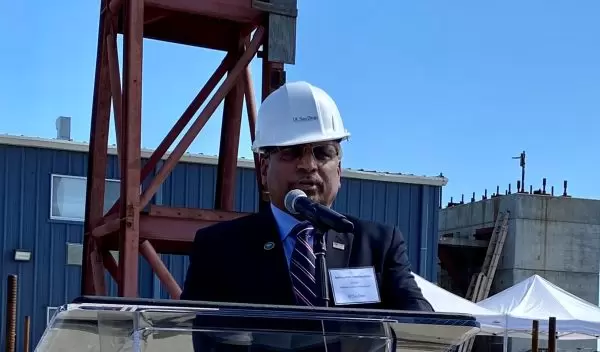
NSF Director visits the world’s largest outdoor experimental earthquake infrastructure facility
LA JOLLA, Calif. -- Today, U.S. National Science Foundation Director Sethuraman Panchanathan met with staff and students from the University of California San Diego, local officials and industry partners to observe and discuss research investments and technology that help recognize and mitigate the impacts of natural disasters across the U.S.
Panchanathan also attended the grand reopening of the upgraded NSF Natural Hazards Engineering Research Infrastructure shake table, a state-of-the-art research facility that enables engineers to test infrastructure by simulating earthquakes under a full range of motion.
"There is no doubt that as our planet continues to evolve, extreme weather events, like severe storms, floods, earthquakes, and wildfires are likely to cause unprecedented damage to infrastructure, communities, and ecosystems," said Panchanathan. "As we look to build a more resilient country, we must continue to leverage our science and engineering expertise to expand prosperity for our nation’s communities and protect the critical infrastructure that supports them."
During his visit, Panchanathan met with faculty and students, and heard from a panel of NSF Faculty Early Career Development awardees. The CAREER program offers NSF's most prestigious awards in support of early-career faculty who have the potential to serve as academic role models in research and education and to lead advances contributing to the missions of their institutions.
Researchers also provided a demonstration on aerosols, climate and the Scripps Ocean-Atmosphere Research Simulator. SOARS, an NSF investment, is the first-of-its-kind simulator designed to study the current and future ocean/atmosphere boundary layer, including the manipulation of variables like greenhouse gases and air pollutants that are important in understanding future climate scenarios.
The University of California, San Diego unveiled the upgraded NHERI shake table, which now boasts a full range of motion for research testing. The shake table is part of the NSF NHERI program, which provides researchers access to large, shared, state-of-the-art facilities to study natural hazards and the performance of civil infrastructure. Panchanathan gave remarks during the reopening, noting the impact this San Diego-based facility will have for the nation.
“The ability to test infrastructure under a full range of motion is critical for unleashing new and pioneering research that can lead to effective, economical and innovative infrastructure designs and retrofitting strategies for existing infrastructure. This research will advance resilient futures by unlocking a new generation of natural hazard mitigation strategies that can save lives,” said Panchanathan.


